Clean off the mold from your shoes by wiping them down using vinegar and water mix to kill the fungal spores. Put half a cup of water, and half a cup of white vinegar into a bucket and use a clean cloth to wipe your shoes down, both inside and out, to remove the mold.
Do this outside as it allows fresh air to get to your shoes and also stops you from keeping the mold spores indoors where they can grow.
Once wiped down in the vinegar solution, your shoes must be left to dry naturally with as much ventilation as possible.
A few weeks ago, it was date night, so I went into my closet to find my best pair of dress shoes.
I hadn’t worn them in a couple months, but I figured it was no big deal.
And then I noticed it had a ton of—is that mold?
Turns out, I’m not the only one who’s had this problem. And right now, you’re wondering how the heck it happened to you, too.
Don’t worry—this is way more common than you’d think.
There’s an easy solution to get your shoes back to normal, remove the mold, and a few ways to prevent it from happening again.
Table of Contents
What Causes Mold on Shoes?
Mold is one of the byproducts that a fungus can create, and if there’s one environment that mold loves, it’s somewhere damp and humid with something porous to get its teeth into.
For mold to grow on your shoes, either your shoes are warm, damp, or both. If you’re storing your shoes in a warm closet with wooden shelves, you might as well throw a bag of fertilizer in there. Mold loves wood; the damper and warmer, the better.
We’ve all seen that mold can grow on that roll you left on the counter overnight quickly and can appear on your shoes with alarming speed. Wearing your shoes and then putting them away in the wrong place can turn them into a breeding ground for mold.
The insole could still be damp from sweat, and your feet nicely warmed the shoes. You’ve already created the perfect environment for mold, so placing them in a humid wooden closet that probably already has mold spores is just asking for trouble.
How to Prevent Your Shoes from Becoming Moldy
You can never entirely avoid mold issues, especially if you live in a humid climate, but there are several great ways to make life as hard for this unwelcome fungus as possible.
It’s all about prevention. Mold loves damp conditions, so when you’ve worn your shoes, let them dry off before storing them.
I’ve put together three hacks to ensure you never have to worry about moldy shoes again. They’re all preventative rather than cure; following one or all of these hacks will keep your shoes in better condition, prevent mold from being an issue, and perhaps add years of life to your shoes.
Hack #1: Use Cedar Shoe Trees
The best way to prevent mold is to let your shoes get plenty of fresh air and use something like a shoe tree to absorb moisture that’s still inside them.
The Stratton Cedar Shoe Tree is our go-to pick for quality. They’re very effective at reducing moisture in your shoes. The wooden trees slip inside your shoes and absorb the dampness from your insole, starving mold of one of its most important food sources.
Made from American Red cedar wood, these are our go-to shoe trees for reducing moisture in your shoes. They're adjustable for all sizes and the spring is strong yet responsive so it comes in and out of your shoe with ease.
Think of mold as an unwelcome lodger; the quickest way to get someone to leave is to turn off the heating and stop feeding them.
Mold needs damp, moist conditions, so starve it of that by ensuring your shoes are adequately dried. Don’t use artificial heat; use a natural breeze or allow them to stand in a cool, well-ventilated area.
Hack #2: Storing Your Shoes with a Shoe Rack
Are you just throwing your shoes in the closet? Stop.
Humidity is another factor to consider when storing your shoes. A metal shoe rack in a well-ventilated area is ideal for keeping your shoes in top condition. The Kottwca Shoe Rack can hold an eye-watering 50-55 pairs of shoes and since there’s no wood for mold to grow on, your shoes get a constant stream of fresh air.
A closet will retain heat and dampness, and mold loves to find porous wood to grow on. It’s a recipe for disaster. A closet looks like a refrigerator to fungi, full of nice things to eat.
Using a metal shoe rack, the soles of your shoes get air to them too, which is vital if you have leather soles.
Mold doesn’t care where on your shoes it grows, and will love getting onto a leather sole that has been through a few puddles to dampen it up.
To my shame, I’ve got a Kottwca Shoe Rack and have been considering buying another as I’m a shoeholic. I bought mine for the storage space; it was only afterward that the added benefit of my shoes getting air to them and keeping the mold away was brought to my attention.
The Kottwca Shoe Rack can hold an eye-watering 50-55 pairs of shoes and since there’s no wood for mold to grow on, your shoes get a constant stream of fresh air.
Hack #3: Regular Shoe Care Prevents Mold
Looking after your shoes will go a long way to keeping them free from mold, as well as prolonging their lifespan. As part of your routine, you should always keep your shoes free from dirt, preferably with a horsehair brush or dry cloth.
If your shoes are leather, then as part of their care, I use Saphir Renovateur to condition and add an extra layer of weather resistance to your shoes. It’ll keep the natural oils in your shoes, prevent cracking, and will keep them looking brand new.
This suede and nubuck spray is formulated with sweet almond oil to enhance the appearance of napped leathers and protect the surface from water stains. It's fantastic at keeping the natural oils in your shoes. It also prevents cracking, and will keep them looking brand new.
When using any leather conditioner, try a bit on the back of the heel to check what color the oil may turn your shoes. If your shoes are clean, well-maintained, and dry, then mold should have a hard time getting a hold on the materials.
If you wear additional insoles inside your shoes, don’t forget to replace them regularly. The insole absorbs moisture and heat, making it a tempting appetizer for fungus.
Again, this hack is preventative—we’re starving the mold of what it needs, humidity and warmth. Be thankful you’re not Dutch; wooden clogs with a warm, damp insole? The stuff of nightmares.
What happens if you wear moldy shoes?
Wearing moldy shoes doesn’t just look terrible. It can be harmful to your health too. Whether you’re asthmatic or not, breathing in the spores from mold can cause a sore throat, wheezing, rashes, and burning eyes. Asthmatics could have a severe allergic reaction or even a nasty infection..

How to Clean Moldy Shoes
Mold can grow on almost anything, so if you think your shoes are safe because they’re made of modern material, think again. If mold can grow on paint, it can grow on your shoes.
Thankfully, it’s not hard to remove mold from most shoes. It just requires a few simple ingredients and some elbow grease.
How you clean the mold from your shoes depends entirely on the material your shoe is made of.
Some shoes, such as those with canvas or smooth leather, can be brushed off and then cleaned with either white vinegar or rubbing alcohol. For others, such as suede, you’ll need a proper suede cleaner or unfinished leather.
Canvas or fabric shoes can be treated the same way leather shoes can and won’t be damaged by rubbing alcohol or white vinegar. One slight difference is that you’ll need to wash your canvas shoes before drying them out.
Hot soapy water and a bit of scrubbing will remove the smell of vinegar or alcohol and stop the funny stares as people wonder why you smell of liquor at 9 am on a Tuesday.
Don’t put your canvas shoes in the washing machine. A bucket of warm soapy water will do less damage and get the job done.
Here’s What to Do
Leather is both porous and absorbent, so it’s an ideal breeding ground for mold.
If you find mold growing on your leather shoes, it’s often relatively easy to remove, at least to the naked eye, but there are things you need to do to make sure you don’t damage the leather.
What You’ll Need
- A shoe brush
- White vinegar or rubbing alcohol
- Warm water
- A bucket
- A clean cloth
- Rubber gloves
- Face mask
- Mink oil
1. Brush Off the Mold
You’ll need to remove the mold spores from the shoes, so the first thing to do is to use your shoe brush to firmly brush off the mold from your shoes. Since mold spores can cause irritation or worse, ensure you’ve got your rubber gloves and face mask on to protect yourself.
2. Mix Your Cleaning Solution and Spray
At first glance, your shoes look much better, but you need to ensure no harmful spores are ready to grow back. Mix a half cup of white vinegar or rubbing alcohol with a half cup of water into a bucket, and then wipe down your shoes using a clean cloth.
It’s not a bad idea to wipe down the inside and outside of your shoes to make sure there are no hidden spots of mold, and once you’ve cleaned them thoroughly, wipe off any excess liquid. A white vinegar and water mix is gentle enough not to damage your leather but strong enough to kill off any mold spores.
3. Drying Off Your Shoes
Once satisfied, you’ve removed any mold and wiped down the leather with white vinegar and water mix. It’s time to dry off your shoes. It’s essential to leave them to dry naturally, don’t use a heater or place your shoes on a radiator to dry.
On a radiator, you can dry out the leather, causing it to crack, and you’ll be supplying warmth to your shoes that could encourage mold to return. Place your shoes somewhere like a metal shoe rack or somewhere they’ll get a natural breeze and some sunlight.
4. Conditioned to Last
Leather needs a bit of TLC after being cleaned down with vinegar or rubbing alcohol, as the leather can dry out quickly. After your shoes are dry, it’s one final step to ensure they’re conditioned and ready to go. Use Fleibing’s Golden Mink Oil to ensure the leather is supple and conditioned, and your leather shoes will look brand new.
Leather needs a bit of TLC after being cleaned down with vinegar or rubbing alcohol, as the leather can dry out quickly. After your shoes are dry, it’s one final step to ensure they’re conditioned and ready to go. This mink oil works really well to make leather supple and conditioned, and help your leather shoes to look brand new.
Can You Put Moldy Shoes in the Washing Machine?
It’s a bad idea to put moldy shoes in the washing machine, and it will more than likely end up ruining your shoes. Leather shoes will become so damp that the leather will split and, after being thrown around in a spin cycle, will likely be unwearable.
Fabric or canvas shoes could survive, though they could still split or even damage the washing machine. Using a bucket of warm water is safer, more reliable, and cheaper than replacing a pair of shoes or a washing machine.
Moldy clothes or sheets can be washed, and the mold will be removed, but shoes can’t take the hammering a washing machine gives.
It’s tempting to try; a quick spin in a washing machine could have your shoes looking sparkling clean. But the chances are even higher that your shoes will be ruined, and you’ll have to explain to your partner why the washing machine has bought the farm.
Conclusion
Moldy shoes are fixable if you catch the mold quickly enough, and with a bit of work, your shoes can look brand new.
Cleaning the mold off is easy, using water and white vinegar. The trick is knowing how to avoid mold or ensure it doesn’t happen again.
A bit of time conditioning your shoes with Saphir Renovateur will keep the leather in top condition.
This suede and nubuck spray is formulated with sweet almond oil to enhance the appearance of napped leathers and protect the surface from water stains. It's fantastic at keeping the natural oils in your shoes. It also prevents cracking, and will keep them looking brand new.
Just don’t put them in a closet to go musty and moldy again. A shoe rack such as the Kottwca Shoe Rack isn’t just handy for storage, the airflow is excellent for keeping shoes fresh and mold-free.
The Kottwca Shoe Rack can hold an eye-watering 50-55 pairs of shoes and since there’s no wood for mold to grow on, your shoes get a constant stream of fresh air.
For more articles on how to keep your shoes looking great and lasting longer, why not subscribe to the Shoebly Youtube Channel?
FAQs
How do you stop mold from growing on shoes?
Keeping your shoes moisture-free will go a long way to preventing mold from growing on them, and a handy trick is to put silica packs inside each shoe to soak up any excess moisture. The little silica packs you get inside appliances are fine, so it’s worth keeping any that you come across.
What kind of mold grows on shoes?
A fungus known as Xerophilic fungi is commonly to blame for mold spores, as it holds moisture well and doesn’t need the temperature to be too humid. Xerophilic fungi can also survive on low levels of water, which means there doesn’t even have to be too much moisture in your shoe for the mold to grow.
How long does it take for mold to grow on shoes?
Depending on the conditions, mold can take hold of your shoes within 24 hours of you putting them away while still damp. Within 3-12 days, the mold will have a good grasp on your shoes, and within three weeks, you could see the mold with the naked eye. The mold could grow exponentially in warm weather and if your shoes are damp or near moisture.
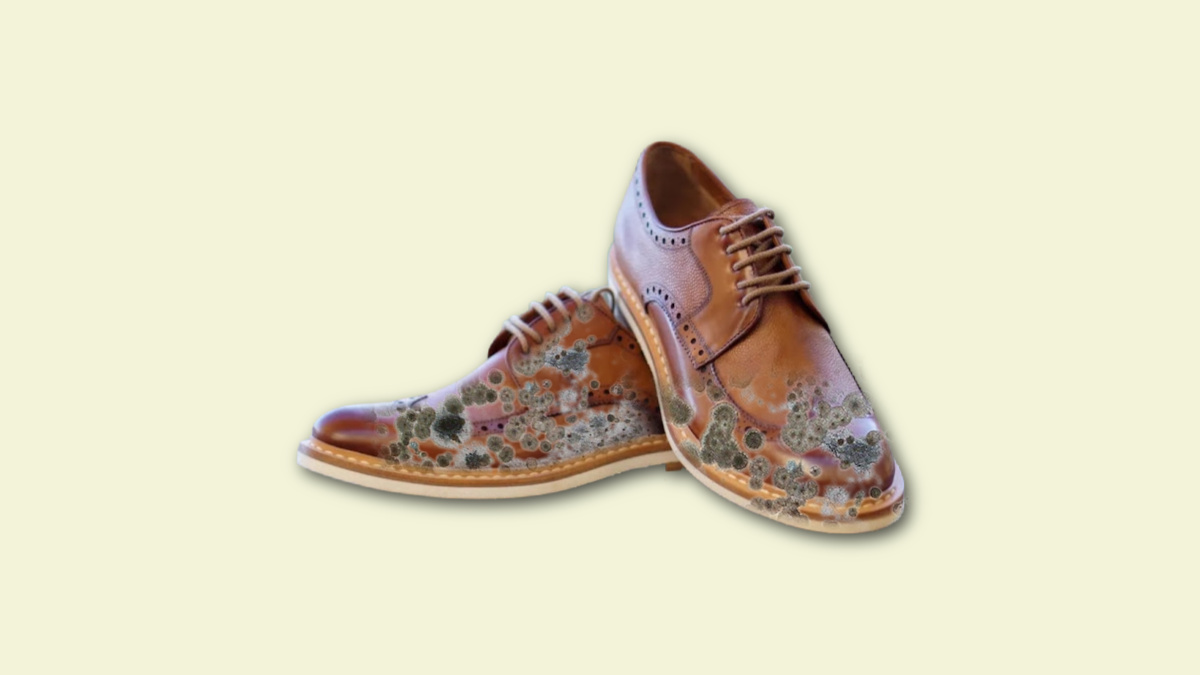
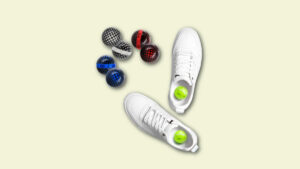
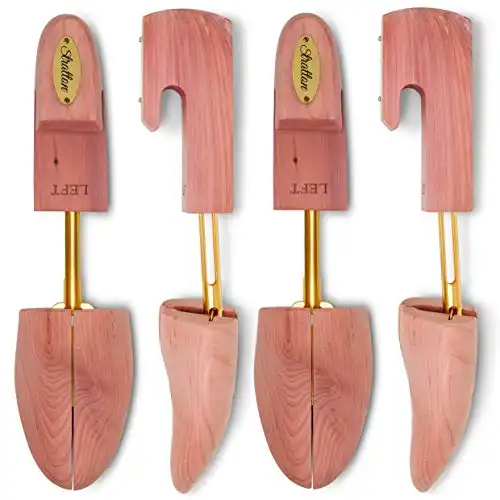
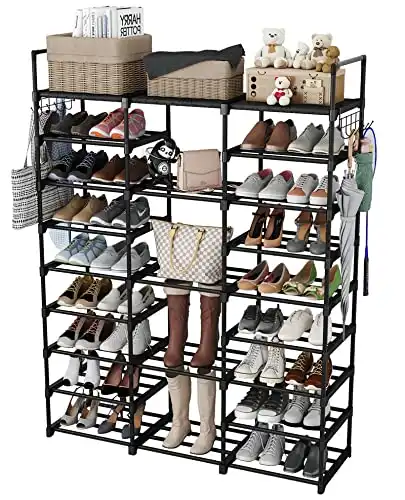

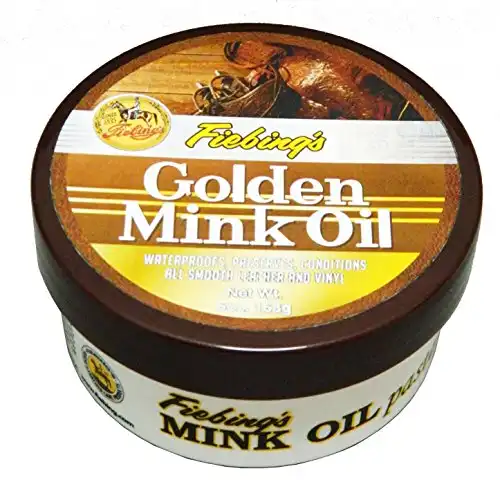

Join the Discussion